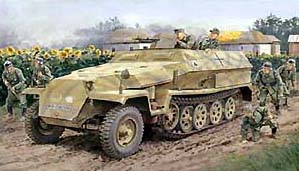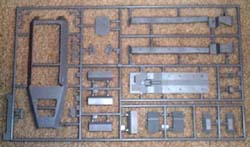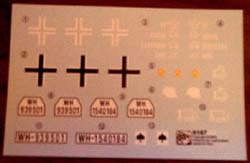Dragon 1/35 Sd.Kfz. 251 Ausf. C
Kit no. 6187
MSRP: $30.95
|
 |
History
The idea for the 251 half-track series of vehicles was to fit a lightly
armored shell to a half-track chassis. Development began in 1937. Hanomag
undertook the design of the chassis while Bussing-NAG produced the armored
body. The vehicle used as a basis for the design was the three-ton prime
mover the Sd.Kfz 11.
Designated as the Sd.Kfz. 251, Allied sources later referred to it
as the Hanomag; the German Army's term for such vehicles was Schutzenpanzerwagen,
abbreviated as SPW. Series production commenced in June of 1939 and continued
until September 1943.
The basic infantry carrier was fitted with a 7.92mm machine-gun behind
a small armored shield at the front of the vehicle. A second machine-gun
was located at the rear, on a high-angle mounting. The two-man crew remained
in the vehicle, but the infantry section in the open troop compartment
deployed via twin rear doors.
The second most numerous sub-class looked almost identical, being the
ammo carriers for tank and artillery units as well as the machine-gun
and mortar companies of the panzergrenadier battalions.
There was only one problem with the Sd.Kfz. 251s: there were never
enough of them. The numbers built fell far short of the quantity needed
to equip every panzergrenadier unit. In general, only one of the four
or six panzergrenadier battalions in a panzer division would be mounted
on half-tracks; the bulk of the troops remained in lorries.
This severely reduced the ability of the panzergrenadiers to fight
in conjunction with the tanks. Their unarmoured trucks were vulnerable
to enemy fire and had only limited cross-country mobility. The battalion
in half-tracks could not be everywhere at once.
What's in the box?
The kit comes in a large tray and lid type box.
The box art, by DML's resident artist Ron Valstad, shows a Sd.Kfz. Ausf.
C of the Grossdeutschland Division moving through what appears to be a
Russian village, with a squad of five German panzergrenadiers alongside
and two crewmen inside the fighting compartment. A side panel of the box
shows five color photos of the model made up.
Shrink-wrapped, to the bottom of the box, is a full color instruction
sheet for the assembly of four German panzergrenadier figures that are
included in the kit as a BONUS and called 'optional parts'. However, these
figures are not the poses shown on the box art. Also, you do not get the
two crewmen shown in the fighting compartment on the box art, but you
do get a driver figure not shown there.
The kit contains seven cello bags that hold 13 trees of medium gray
parts, the decal sheet and the assembly instructions.
The instructions consist of a large sheet that accordian folds out
into 8 pages. It is the older way of doing an instruction sheet for DML.
They recently went to a new way that has full color actual pictures of
the kit parts in the assembly steps printed on high gloss stock. In the
kit you get line drawings in black and white. There has been preferences,
both ways, on how individual armor modelers like one or the other method.
I remain neutral.
Page one of the instructions begins with a black and white repeat of
the box art. There is no history of the vehicle given. This then is followed
by parts tree drawings.
Page two begins with some general cautions in six different languages,
followed by assembly symbol explanations and a paint color listing to
use to paint the model. The bottom of the page gives the first two assembly
steps.
Pages three through seven give us the balance of a total of 14 assembly
steps.
Page 8 shows two color scheme drawings:
-
A vehicle of the 'Grossdeutschland' Division, Kursk 1943 (featured
on the box art).
-
A vehicle of the 14th Panzer Division, Ukraine 1942.
Large size letter 'A' parts tree holds: the vehicle's upper body shell,
nose piece, floor, fenders, view flaps and numerous bins etc. (25 parts)
Large size letter 'B' parts tree holds: the vehicle's side parts, more
vision flaps, tools, bench seats for the rear compartment, fire wall,
driver's control levers, radio, fire extinguisher, two MP 40 machine pistols,
MG 34 shield etc. (39 parts).
Medium sized letter 'C' parts tree holds: leaf springs, two MG 34 machine-guns
(one is marked as excess - not used for this model), undercarriage parts,
steering wheel, body panels, extra fuel tanks and head lamps etc. (48
parts).
There are two identical small sized letter 'D' parts trees. These hold:
eight rifles, two jerry cans, driving compartment seats and various panels
etc. (42 parts per tree).
The small bottom chassis tub part is also called out as letter 'D'.
There are two identical medium sized letter 'E' parts trees. These
hold: individual tread links - which are done in two pieces each - the
metal part and the rubber block that goes in the center, road wheels,
front tires and rims (which can be made steerable) and drive sprockets.
Molding the metal area of the links as one piece and the rubber blocks
as another will make for tedious assembly work, but painting will be a
breeze that way.
The decal sheet is inside the cello bar with the two letter 'E' trees.
There is another large cello bag that contains five more trees of the
bonus/optional figure parts. There is also an optional frontal suspension
armor plate provided. The figures are very nicely done and there are many,
many pieces of personal gear and weapons provided too. There is even a
loose jacket and boots included.
This kit is well molded. Detail is crisp and no flash is evident on
any parts.
The old Tamiya offering of the 251 is close to 20 years old now, so
this new kit is very welcome and state of the art for the detail we expect
from kits now.
AFV Club has announced a kit of the Ausf. C too. I have not personally
seen this kit and cannot say how it compares with the DML offering.
Very highly recommended.
I bought my kit at my local hobby shop.
|
|


